The life of Lovecraft - a hickey, a racist and a genius (19 photos)
About the life and books of the writer. 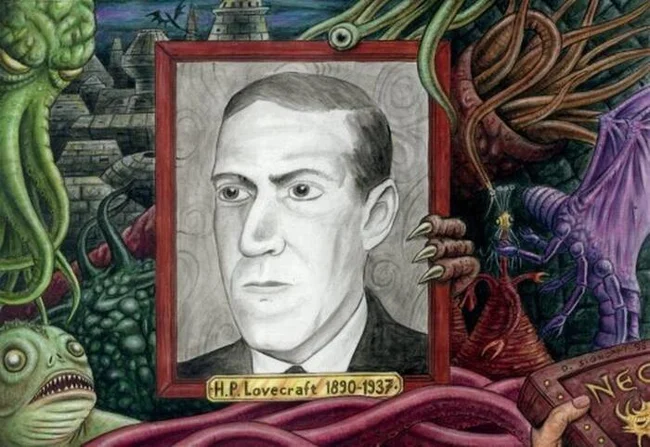
Fear is the oldest and strongest of human feelings, and the oldest and most powerful fear is the fear of the unknown.
Howard Phillips Lovecraft "Supernatural Horror in Literature"
In some ways, Howard Lovecraft is luckier than many other authors. This is not about success in book publishing: during Lovecraft’s lifetime, only one of his novels went into print, and his stories were published in cheap magazines, where they published just about anyone. And not about a bright, eventful life: hardly anyone will be impressed by moving from one house to another at a distance of several tens of meters...
Lovecraft accomplished something more. A man who throughout his life was amazed at any secrets (more often imaginary than real), turned his biography and work into a “Lovecraft phenomenon”, causing, if not amazement, then bewilderment. 
Before us is a very contradictory personality. A homebody who wrote with gusto about deadly journeys and terrifying unknown spaces. A dense, full-blown xenophobe in words, but who did not adhere to these principles in real life. Almost unknown during his lifetime - and unexpectedly becoming popular after his death...
Let's take a closer look at the horror classic.
Library and telescope
He was a tall, thin and fair-haired young man with serious eyes, slightly stooped, dressed with slight carelessness and gave the impression of a not very attractive, awkward, but harmless young man.
Howard Phillips Lovecraft "The Case of Charles Dexter Ward"
On August 20, 1890, the only and, by then standards, late child of traveling jewelry salesman Winfield Scott Lovecraft and his wife Sarah Susan Phillips was born in Providence, Rhode Island.
Winfield and Sarah came from old American families that had settled in the New World since 1630. Being a descendant of the first settlers was considered an honor. This “aristocratic” origin seems to have shaped the writer’s intolerant views.
All of them turned out to be people of mixed blood, extremely low mental development, and even with mental disabilities.
A typical Lovecraftian description of the servants of dark cults
His mother’s sisters, Lillian Delora and Annie Emeline, and his grandfather Whipple Van Buren Phillips, a businessman, inventor and bookworm (who, by the way, collected the largest library in Providence) lived in the large family house at number 454 Angell Street. The help of relatives came in very handy three years later, when Winfield Scott had to be urgently hospitalized in the Providence Butler Hospital psychiatric hospital in a state of acute psychosis. No matter how doctors tried to improve Lovecraft Sr.’s condition, things got worse, and in 1898, at the age of only forty-five, Howard’s father died of nervous exhaustion.
Of course, surrounded by four loving adults, Howard did not go unnoticed. Van Buren especially often worked with his grandson. Fortunately, the boy grew up as a child prodigy: he voraciously read classics and Arabic fairy tales, and from the age of six he began writing poetry and stories. Young Lovecraft also became familiar with Gothic prose from childhood: there were plenty of such books in the home library, and his grandfather - a clearly creative man, but, unfortunately, who did not write down his works - often told his grandson dark, mysterious and exciting stories.
Howard's first literary story was "The Beast in the Cave", written in 1905. Unfortunately, his enviable intellect was accompanied by extremely poor health. The boy was constantly ill, and although he could still go to school until he was eight years old, albeit with long absences, after that he fell ill for a whole year and was expelled.
However, it cannot be said that he wasted time - thanks to his grandfather, Howard became interested in history, chemistry and especially astronomy, and even began publishing The Scientific Gazette and The Rhode Island Journal of Astronomy magazines, dedicated to his scientific research.
At first, Lovecraft's articles were very childish, but soon he was noticed by serious publications. Already in 1906, his article on astronomy was published by The Providence Sunday Journal. Howard then became a regular astronomy columnist for The Pawtuxet Valley Gleaner. And then other publications became interested in his scientific articles: The Providence Tribune, The Providence Evening News, The Asheville (N.C.) Gazette-News.
Howard's other problem was dreams. Nightmares, hallucinations, like vile winged creatures that carried the boy to the Lang plateau, or Dagon emerging from the thickness of the fetid waters - all this exhausted an already fragile body. Time after time, Lovecraft woke up in a panic with his heart beating wildly and could not move - he was overcome by night paralysis.
Night paralysis is a condition in which a person wakes up before he is able to move, or falls asleep later than the muscles completely relax. Often accompanied by irrational horror, suffocation, disorientation in space, and fantastic visions.
Changes occurred during sleep. I cannot remember in detail how it all happened, since my sleep, being restless and full of various visions, nevertheless turned out to be quite long. When I woke up, I discovered that I was half-sucked into the slimy surface of a disgusting black quagmire, which stretched around me in monotonous undulations as far as the eye could see.
Howard Phillips Lovecraft "Dagon"
In 1904, a new misfortune befell the family - grandfather Van Buren died. Financial affairs fell into complete disarray, and Howard and his mother had to move to a small apartment on the same street - 598 Angell Street. 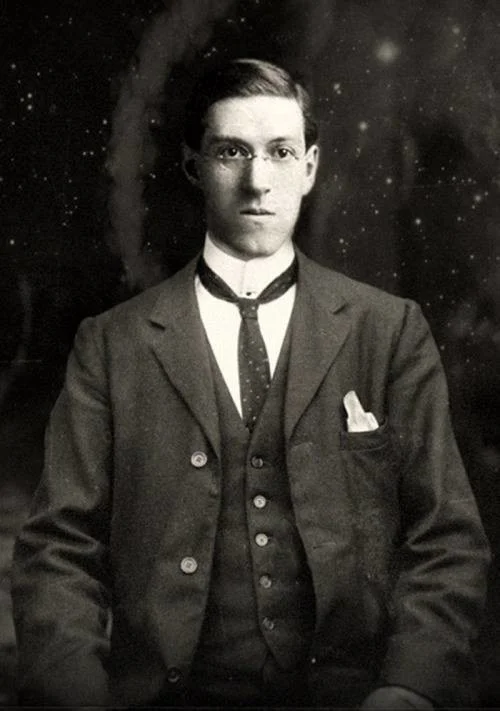
Many of Lovecraft's characters were like him
The loss of his grandfather and his home, where he felt at least somehow protected from the frightening world, hit Lovecraft painfully. He began to think about suicide. However, I was able to pull myself together and even go to a new school - Hope High School. Howard was unexpectedly lucky - both with classmates and especially with teachers who encouraged his scientific interests. But poor health still failed, and in 1908, after a severe nervous breakdown, Lovecraft dropped out of school without receiving a high school diploma. Howard was ashamed of this detail of his biography: sometimes he hid it, sometimes he outright lied.
Things didn’t work out further with my education—my attempt to enroll at Brown University failed. It seemed that the future did not promise anything good. So Lovecraft became a recluse and barely left his house for five years.
Rescue for hickey
When describing the next period of Lovecraft's life, it is difficult to resist the thought that the events take place at the beginning of the 20th century, and not a century later. Let's imagine this picture. An eighteen-year-old young man, whose only interests are astronomy and literature, lives with his mother in a small apartment, communicates with almost no one and only reads and reads... What is missing to complete the image? Active correspondence on Facebook or VKontakte, flame-driven posts generating kilometer-long comment feeds, with massive boyfriends and boyfriends, swearing and likes? Well, why, and that was it!
Issue of The Argosy with story by Jackson
In place of Facebook was the pulp magazine for teenagers The Argosy, where in 1913 a story by Frederick Jackson that caught the eye of Lovecraft was published. It’s hard to say why he didn’t like the mediocre love story so much (at that time there were plenty of them in pulp magazines), but Howard wrote an extremely emotional letter to the editor, in which he tore Jackson’s creation to smithereens.
Jackson's fans reared up, and a long, furious correspondence ensued on the pages of the magazine, involving many people. This included Edward Daas, who then headed the United Amateur Press Association (UAPA), an organization of young American authors who self-published and wrote in their own magazines. 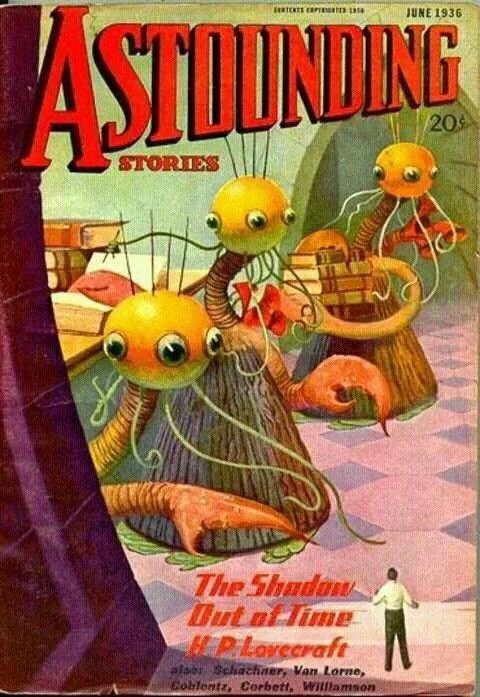
Having taken a closer look at Lovecraft, Daas invited him to join the UAPA. He agreed and began publishing The Conservative magazine (a total of 13 issues were published between 1915 and 1923), where he published his poems, articles and essays. The main thing is that, feeling in demand, he was finally able to leave the house and live a much more fulfilling life, surrounded by people, and not just books. 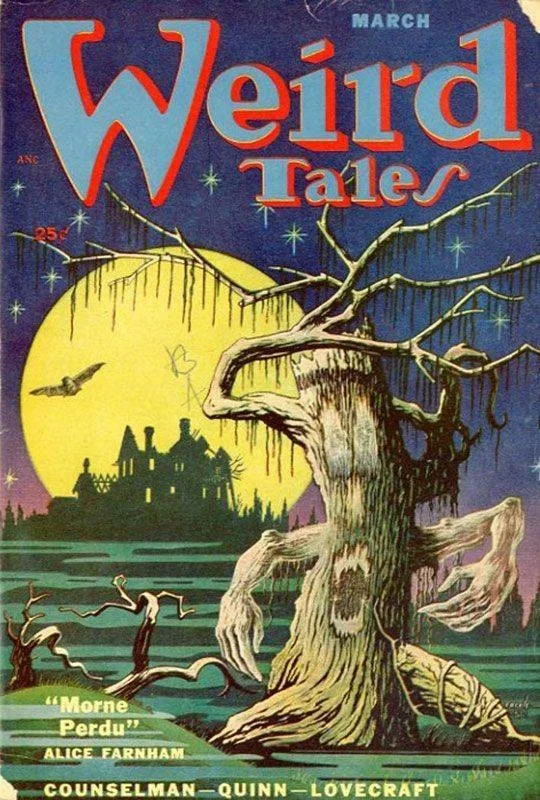
With the books, however, everything was also in order. Lovecraft began writing stories again: in 1917, “The Crypt” and “Dagon” were published, then “The Remembrance of Dr. Samuel Johnson”, “Polaris”, “Beyond the Wall of Sleep”, “The Reincarnation of Juan Romero”... Those that tormented him in childhood Lovecraft melted nightmares into fantastic stories - fortunately there was no shortage of material. 
Pulp Fiction
Pulp magazines (from the word pulp - pulp from recycled materials and cheap paper made from it), despite all the neglect of intellectuals towards them, performed an important function. They provided an opportunity to read literature—even if not the best—for those who could not pay dearly for it. Workers and employees on a pittance salary who wanted to relax after work. Children and teenagers who had even less money, but needed food for imagination. Or simply people who had to travel far or wait a long time.
The first American palp magazine was The Argosy (“Merchant Ship”): it began publication on December 2, 1882 and lasted until 1978. At first it was called Golden Argosy, aimed at children, published once a week and cost five cents, but it soon became clear that this policy was not paying off. Since 1894, the magazine became monthly and ten-cent and began publishing detective stories, mysticism, westerns, gothic, stories about travelers, pirates, gold miners... What you need to distract yourself and have fun. 
The Argosy was followed by The Popular Magazine, Adventure, All-Story, Blue Book, Top-Notch, Short Story, Cavalier... At the beginning of the 20th century, there were dozens of magazines - and they changed (and shaped) mass culture.
Communication with people - writers' conferences, meetings with colleagues and readers, copious correspondence - helped Lovecraft endure another blow. In 1919, after many years of depression, his mother's condition deteriorated sharply. Sarah Lovecraft was hospitalized at the same Butler Hospital, where her husband was treated unsuccessfully. Her condition, however, was better - she could at least write letters, and continued to maintain relations with her son until her death in 1921.
It’s difficult to say what would have happened to Lovecraft—he took the death of his mother hard—if he had not had an outlet in the form of writing events where he was welcome. A couple of weeks later he went to Boston for a conference of amateur journalists - and there he met Sonya Haft Green. A successful hat shop owner, a self-made woman who was widowed five years ago after a failed marriage, she was also a pulp writer, an amateur publisher, and a sponsor of several fanzines. Common interests brought Howard and Sonya closer together, and on March 3, 1924, they got married.
Sonya Green - née Shafirkina, daughter of Simon and Rakhil Shafirkin from the city of Ichnya, Chernigov province - by origin, it seems, did not fall into the category of “right”, “one of our own”, so important for Lovecraft - at least judging by his works. But when theories and real life collide, more often than not, theories lose. Meeting an intelligent and charming lady made Howard forget about his views... however, only for a while.
Our own not-our own
As a rule, when it comes to xenophobia, it can be clearly defined. For example, this person is an anti-Semite. Or a white racist. Or black...
Not so with Lovecraft. His xenophobia did not limit itself - why waste time on trifles? Indians, Eskimos, blacks, Egyptians, Hindus - everyone, literally all of them, with the help of their nightmarish rituals, are going to destroy civilization, humanity and the Earth! 
In the board game "Arkham Horror" you can take the local priest Ivanitsky as an ally
However, there was one foreign people who did not fall into the category of “strangers” for the writer. These are... Poles! Poland's turbulent history and economic problems in the 19th century led to mass emigration abroad. There were many representatives of the Polish diaspora in New England. The Poles, familiar from childhood, did not bother the trembling soul of Howard Phillips. From which we can draw a not particularly original conclusion: “The more you know, the less you are afraid.”
Roundtrip
Gilman settled in ancient Arkham, where time seemed to stand still and people live only by legends. Here, everywhere, in silent rivalry, peaked roofs rise to the sky; under them, in dusty attics, in colonial times the Arkham witches hid from persecution by the Royal Guard.
Howard Phillips Lovecraft "Dreams in the Witch House"
At first, Howard and Sonya's marriage was successful. The newlyweds moved to New York, where Lovecraft joined the Kalem Club, a group of writers and intellectuals. He began publishing in the pulp magazine Weird Tales: editor Edwin Bird published many of Lovecraft's stories, despite criticism from some readers. Finally, Sonya took care of Howard’s health - and her husband, who was previously painfully thin, recovered thanks to his wife’s culinary talents. 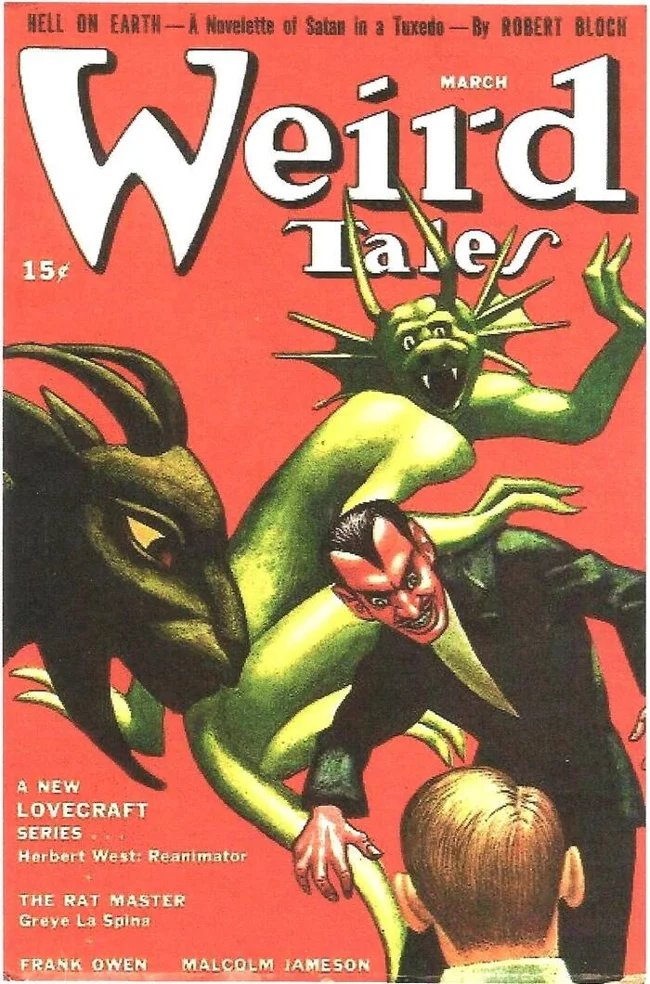
Then things got worse. Sonya went to Cleveland, trying to improve the affairs of her company, but the bank where she kept her savings went bankrupt, and the company went bankrupt. In addition, she also became ill - so, in theory, Howard was supposed to provide financially for the family. But he did not have the habit of systematic work, and he did not have enough professional skills. 
Lovecraft could refuse even lucrative job offers if they were associated with inconvenience for him. So, he was offered a job as an editor at Weird Tales - but for this he had to move to Chicago. “Just imagine what a tragedy this move would be for an old wreck like me,” Howard, 34, responded mournfully. 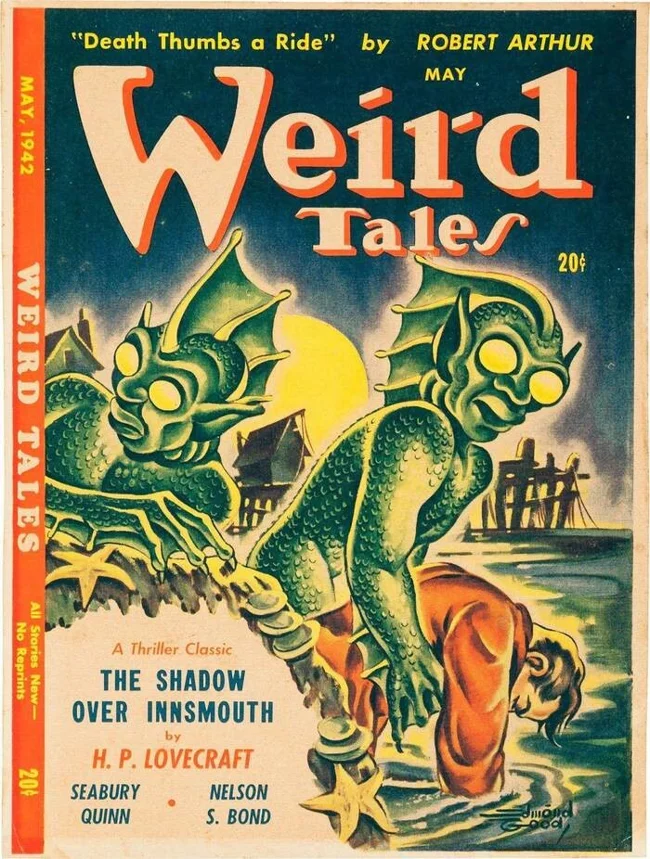
While the sick Sonya was traveling around the States, trying to make money, Lovecraft found himself in New York, becoming more and more dissatisfied with this city every day. He lived on the money that his wife managed to send him, and was forced to move to an apartment on Clinton Street in Brooklyn, where there were many emigrants belonging to different nations and races - this infuriated Howard and horrified him. It was there that he began writing The Call of Cthulhu, the famous story about a cruel deity worshiped by disgusting cultists and who sends deadly nightmares to people (and simply eats them). 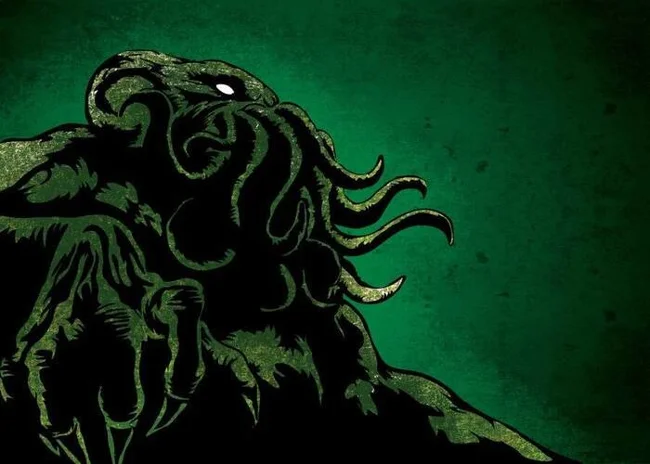
Cthulhu by Danilo Neira (Creative Commons)
Lovecraft rated the Cthulhu story as average, and the editor of Weird Tales (by then Fernsworth Wright) initially rejected it altogether - and published it only when one of Lovecraft's friends lied that Howard would send the work to another magazine. But “Call of Cthulhu” was very loved by the author of “Conan” Robert Howard:
A masterpiece that I am confident will live on as one of the highest achievements of literature... Lovecraft occupies a unique position in the literary world; he has captured, in every respect, worlds beyond our puny horizons.
I must admit: at least within the horror genre, Howard was right. Lovecraft combined gothic horror and science fiction to create a world full of unimaginable monsters. And it's not just Cthulhu.
Lovecraft could not stand such a life for long - and returned to his native Providence. His marriage, in fact, quietly broke up, but it never came to an official divorce. He never saw Sonya again*. And Providence - along with neighboring Salem - became the prototype for Arkham, the most famous city from Lovecraft's works.
After many misadventures, Sonya Green went to California, where she married again - to Dr. Davis from Los Angeles (and Lovecraft was still alive, which actually made the new marriage invalid), then she was widowed again. She wrote a memoir, “The Private Life of Lovecraft,” as Sonya Davis. She lived a long and successful life - and died at the age of 89.
The next few years were Lovecraft's most fruitful. He traveled a lot (mainly in New England, but not only - he also went to Quebec, Philadelphia, Charleston, St. Augustine), gained impressions - and, of course, wrote.
His works of this time are called “the elder Lovecraft texts”: these include the novels “The Ridges of Madness”, “The Shadow Over Innsmouth” and “The Case of Charles Dexter Ward”, short stories and novellas “The Color from Other Worlds”, “The Dunwich Horror”, “Silver key", "Shadow from Timelessness", "Whisperer in the Dark". At the same time, many articles appeared from his pen on a variety of topics: from politics to architecture, from economics to philosophy. Lovecraft continued to correspond extensively with both old friends such as Robert Bloch and younger authors such as August Derleth and Fritz Leiber. 
Christmas card signed by Lovecraft. Well, as signed...
His biographer Lion Sprague de Camp estimates that Lovecraft wrote about 100,000 letters throughout his life (of which only a fifth have survived). If so, he set an absolute record among all people who have ever lived on Earth. Other biographers believe that de Camp's figures are exaggerated and that Lovecraft wrote about 30 thousand letters. But even this number places him in second place - after Voltaire.
Alas, the writer’s financial affairs were getting worse. He published little and rarely, the inheritance on which he lived ended. Lovecraft had to move into a small house with one of his aunts. Health problems caused by starvation (as he tried to save money on paper and envelopes for correspondence) were aggravated by the depression into which Lovecraft fell after the suicide of his close friend Robert E. Howard.
At the beginning of 1937, doctors diagnosed him with intestinal cancer - which had already developed to a condition with which medicine could not do anything. On March 15, 1937, Lovecraft passed away. 
Lovecraft's tombstone, erected thanks to his fans
At first, Lovecraft did not have a separate tombstone - his name and surname were written on his parent’s monument. But when his works became popular, it seemed to his fans that this was not enough. They raised money and in 1977 erected a separate tombstone for their beloved writer.
On it, in addition to the name and two dates, the phrase “I am Providence” is written (this is not a self-epitaph, but simply a quote from one of his letters). This play on words means both “I am Providence” and “I am providence”, “I am God’s providence”. Graceful, pathetic and with a touch of mystery - just what we would expect from Lovecraft. 
Lovecraft's tombstone, erected thanks to his fans
Life after death
Usually, when a person dies, his biography ends. If this were the case with Lovecraft, it is unlikely that we would remember the pulp author of the 1920s and 1930s. Thousands of them. And a book published during his lifetime (The Shadow Over Innsmouth was published in 1936 in Pennsylvania) would hardly have changed the situation. 
But when executors and biographers got to Lovecraft’s literary estate, the situation changed dramatically. First of all, thanks to August Derleth, an average science fiction writer, but a brilliant advertiser and book publisher. He created the Arkham House publishing house in 1939 specifically to publish Lovecraft's works - a rare case in this industry. 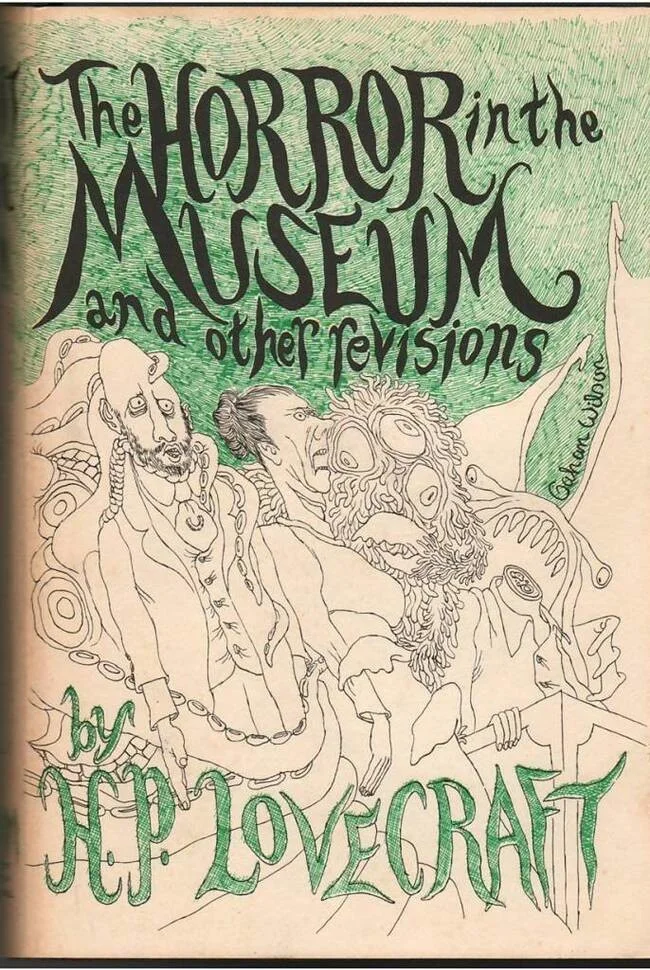
Derleth, an ardent admirer of Lovecraft, helped publish his works during his lifetime. But Lovecraft himself interfered with him: he refused to provide what he had written, declared that he had outlived his usefulness as an author, and so on. But when Derleth was allowed to access the posthumous archives without restrictions, everything began to spin - and to this day, although eighty years have passed, it continues to gain momentum. 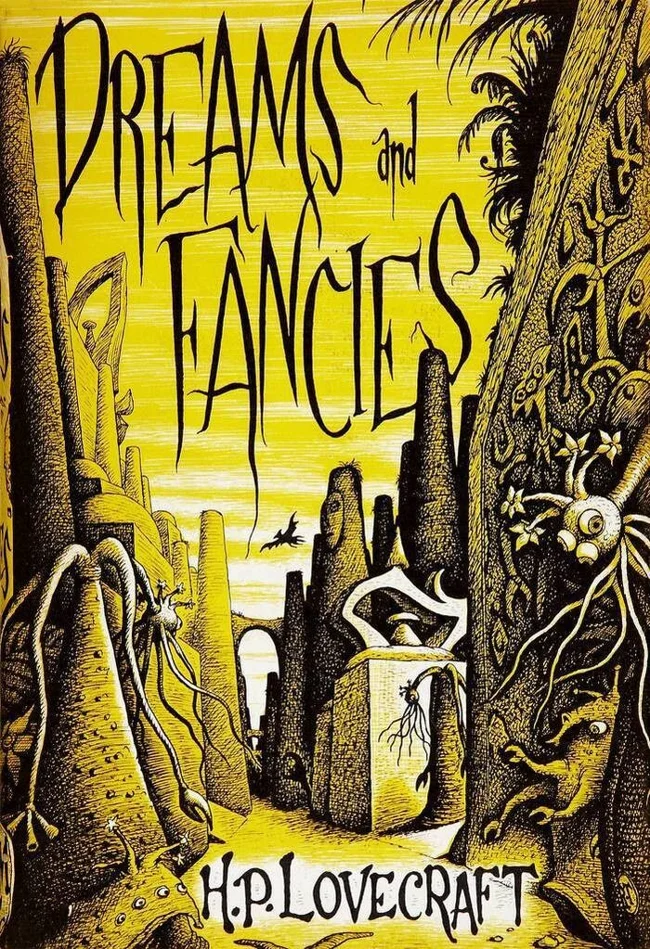
It seems that everything that Lovecraft wrote and that has survived was published, including unfinished works, volumes of letters and inter-author projects. Not only Arkham House took part in this - other publishing houses also joined in.
Several dozen films have been made based on Lovecraft, starting with “The Enchanted Castle” in 1963, which also started the fashion for “Lovecraft plus someone” crossovers, in this case plus Edgar Allan Poe. About fifty computer games and a little less than thirty board games have been created, and a number of rock operas have been recorded. And the number of individual songs, fan art and fan fiction based on Lovecraft simply cannot be counted. And there's no sign that we'll be forgetting Cthulhu, Arkham, and the Lang Plateau anytime soon.
So why Lovecraft?
Why did Lovecraft, not particularly famous during his lifetime, become so popular after his death? Let us venture to offer a possible answer, albeit a rather unpleasant one for us. In short, Lovecraft was ahead of his time. Usually they say this about scientific or other brilliant insights, but here the meaning is different. Let's remember the standard scheme of Lovecraft's works: we lived normally, but we poked our heads where we shouldn't or discovered what we shouldn't - and because of this, someone else's evil is breaking into the world, so terrible that it can't even be described. Moral: there was no point in poking around and opening it. Knowledge multiplies not only sorrow, but also downright chthonic horror.
We live on a quiet island of ignorance in the middle of the dark sea of infinity, and we should not sail long distances at all. The sciences, each pulling in its own direction, have hitherto done us little harm; However, the day will come when the unification of hitherto scattered fragments of knowledge will reveal to us such terrifying views of reality that we will either lose our minds from what we see, or we will try to hide from this destructive enlightenment in the peace and security of the new Middle Ages.
Howard Phillips Lovecraft "The Call of Cthulhu" 
Cthulhu for President! (in this case Poland)
For people of the late 20th and early 21st centuries, this type of horror became a real gift. Because - well, let's look at ourselves honestly. We are locking ourselves away from life in a house of virtual reality and distance communication. We become tense when we are surrounded by strangers—people who differ from us in appearance, clothing, or religion. Our money is spent on isolating ourselves from the rest of humanity, not on space exploration, but we don't mind. We enthusiastically spread horror stories about GMOs, drink bullshit and charged water. And remember the end of the world according to the Mayan calendar - how many representatives of enlightened humanity believed in this “secret knowledge”, which would look great under the same cover with stories about Yog-sothoth, Dagon and Nyarlathotep!
It all looks pathetic. And to ennoble the fear of another synthesized mold or Dolly the sheep, you need pathos, the more the better. This is what Lovecraft generously gave us! “Monstrous deities capable of destroying the universe, and their awe-inspiring and disgusting cults” - this sounds much better than “I’m afraid of Vasya and genetically modified corn.” Not so embarrassing.
Thank you, Howard. You have become a good mirror for us. Well, it’s true that the reflection could have been better. And it’s up to us to sort this out ourselves.
